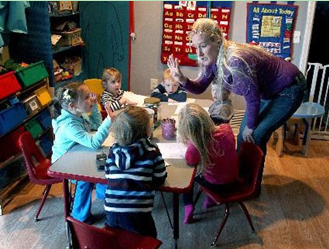增强执行力度?
To aid providers who are struggling with safety and quality, advocates believe Minnesota needs tougher standards and enforcement.
为帮助那些尽力保证托儿所质量和安全的负责人,倡导者认为明尼苏达州需要设定更高的标准和增强执行力度。
Many child deaths reviewed by the Star Tribune involved providers who didn't follow even basic safe-sleeping rules. At least 10 deaths since 2007 involved infants placed to sleep on their stomachs -- a clear violation of guidelines -- or on unsafe surfaces. Several deaths involved napping infants who weren't checked for long periods of time -- in one case three hours.
《星论坛报》查看的众多幼儿死亡事件中,很多都是由于负责人无法执行基本的安全睡眠法则。2007年以来,至少有10起幼儿死亡事件涉及到婴儿背朝天睡觉——明显违反了标准——或在不安全的表面睡觉。数起死亡事件涉及到婴儿睡觉时,长时间无人查看——有一例中,三个小时内,无人查看婴儿。

The state requires that in-home providers and center workers be within sight or hearing of sleeping infants. But only at child-care centers are workers required, in most cases, to visually check sleeping infants every 15 minutes.
明尼苏达州要求婴儿睡觉时,家庭托儿所负责人和托儿所中心员工必须能看到或听到孩子的动静。但是往往只有托儿所中心要求员工每15分钟检查一下熟睡中的婴儿。
In Kansas, which overhauled its child-care rules in 2010, in-home caregivers must check on sleeping children every 15 minutes. It is one of at least six states that require in-home providers to observe children during their nap times.
2010年,堪萨斯州全面修订了照看儿童的规定,要求家庭托儿所负责人每15分钟查看一次熟睡中的幼儿。至少有六个州要求家庭托儿所在孩子小睡期间查看幼儿,堪萨斯州就是其中的一个。
In a May 3 letter to family providers, Minnesota Department of Human Services Inspector General Jerry Kerber said his agency would examine the "vast differences" in death figures between centers and licensed homes, and whether additional training or supervision is needed.
5月3日,明尼苏达州人类服务部监察长杰里·科伯给家庭托儿所负责人寄了一封信,信中说道,人类服务部将查看托儿所中心和获得许可的家庭托儿所之间幼儿死亡率差别如此之大的原因,看看是否需要给家庭托儿所负责人提供额外的培训或监督。
In addition, some advocates believe Minnesota needs better day-care inspections. Child Care Aware of America, a research and watchdog group, estimates that Minnesota has one county inspector for every 150 family child care homes -- 10th worst in the nation.
另外,一些倡导者认为明尼苏达州需要更好的日托所视察。据研究与监督机构美国儿童看护意识估计,在明尼苏达州,每150个家庭托儿所配有一名县级视察员,这在全美倒数前十之列。
Actual rates vary widely by county. In Anoka County, three inspectors have caseloads of more than 200 providers and aren't able to spend as much time with individual providers as they would like.
真实的比率根据不同的县而不同。在安诺卡县,超过200名负责人仅配有3名视察员,视察员无法给每个负责人那里安排尽可能多的时间。
"If we're really wanting to know what's going on in a home, the best way ... is to be there in person, eyeball to eyeball," said Evelyn Nelson, who supervises the Anoka office. "We don't have the people power to do that."
“如果我们真的想知道家庭托儿所的真实情况,最好的办法是派个人在那里看着,”伊芙琳·内尔逊说,“我们没有那么多人力。”内尔逊是安诺卡县视察办公室的负责人。
In 26 states, inspections occur at least once a year, with 14 states inspecting in-home providers twice a year or more, according to Child Care Aware of America's survey. Four states inspect at least quarterly, including Wyoming, where there is an inspector for every 66 home child care providers.
据美国儿童看护意识的调查,全美有26个州每年至少视察一次家庭托儿所,其中有14个州是每年2次以上,包括怀俄明州在内的4个州每个季度至少视察一次。在怀俄明州每68家家庭托儿所配有1名视察员。
Better training?
改善培训?
Better training of child care providers also can improve the quality of care, according to several research studies.
多项研究显示,为家庭托儿所负责人提供更好的培训也能改善看护儿童的质量。
Minnesota requires in-home providers to be trained in first aid and CPR before they are licensed, but no training in child development is required until after they open. The state's requirement of eight hours of annual training was 33rd lowest among 42 states that license small child care homes, according to Child Care Aware.
美国儿童看护意识的调查显示,在明尼苏达州,家庭托儿所负责人获得执照前必须接受急救和心肺复苏术的培训,但是要等到家庭托儿所开业后才要求其负责人接受儿童发展的培训。明尼苏达州要求每年接受8小时的培训,这在给小型家庭托儿所颁发执照的42个州中排名第33位。
Wisconsin requires at least 40 hours of initial training, including child development, and then 18 hours annually.
威斯康星州要求最少要接受40小时的前期培训,其中包括儿童发展方面的培训,并且每年必须接受18小时培训。
"We think [training] increases the likelihood children will be safer in care," said Grace Reef, Child Care Aware's public policy director. "But it's also about healthy [child] development."
“我们觉得增加培训可以提高孩子看护的安全度,”美国儿童看护意识的公共政策主管格蕾丝·丽芙说,“同时还关乎到儿童的健康成长。”
Responding to the Star Tribune's ongoing investigation, state regulators recently recommended increased training in safe sleep positioning and CPR.
明尼苏达州对《星论坛报》的调查做出了回应,管理机构最近建议增加在安全睡眠姿势和心肺复苏术方面的培训。
Yet proposals to increase training can face political resistance. In 2006 Minnesota increased its annual training requirement from six hours to eight after lawmakers opposed increasing the total to 12.
但是增加培训的提议可能会遇到政治上的阻力。2006年,明尼苏达州的立法者反对将培训时间增加到12小时,结果只从6小时增加到了8小时。
"Conservatives railed against 'the nanny state,' " said John Hottinger, a former DFL state senator who sponsored the training bill.
“保守派反对保姆式国家。”支持家庭托儿所培训法案的前参议员约翰·豪廷杰说。
Some legislators remain skeptical of more regulation. "It never ends. We add regulation on regulation, training on training," said Rep. Steve Gottwalt, R-St. Cloud. "Unless you've got real good evidence that six hours results in 'X' amount of better safety for kids, then why not 12 hours? Why not 36 hours? Why not require day-care providers to have a master's degree?"
一些立法者对更多管控持怀疑的态度。“管控无止境。我们在管控上加新的管控,在培训上加新的培训,”共和党员史蒂夫·哥特瓦特说,“除非你有铁证证明六个小时为孩子增加了多少安全度。为何不增加到12小时?为何不增加到36小时?为什么不要求家庭托儿所负责人获得硕士学位?”
Training isn't a cure-all, Wrigley said. Her deaths study concluded that the environment of family child care was more problematic than a lack of education. And Stenseng, the provider who lost her license because she used breast-suckling to control behavior, had college training in psychology and social work.
里格勒说,培训不是万能锁。她的幼儿死亡研究结果是家庭托儿所的环境比其负责人缺乏教育问题更大。斯坦森因为用让孩子吮吸乳房的方法控制他们的行为而被吊销执照,但她本人接受过心理和社会工作的大学培训。
Stenseng said she created her own licensed child care because she was dissatisfied with options for her children and wanted to create a facility that supported alternatives such as cloth diapers, attachment parenting and extended breast-feeding. She disagreed with the state report, arguing that most parents were aware of her "comfort nursing" practice. "To them," she said, "it was a very natural fit" with their parenting philosophies.
斯坦森说她办了自己的托儿所是因为她不满意看护孩子方法的限制性,她想要办个支持额外做法的托儿所,如布尿布、亲密育儿和延长母奶喂养等。她不赞同明尼苏达州的报告,反驳道大多数父母都知道她的安慰式抚养法。“大多数父母觉得,”她说,“我的做法很自然地吻合了”他们的育儿理念。
Katy Chase of the Family Child Care Association believes providing more mentors would raise child-care quality. Public funding covers mentoring for only five providers a year, she noted.
家庭托儿所协会的成员凯蒂·蔡斯认为提供更多的培训会提高育儿的质量。她还提到,公共资助每年只覆盖5名家庭托儿所负责人。
Payne, the author of national child-care guidelines, said ultimately it's up to states to ensure safety at home-based day care.
《全美育儿指导》的作者佩恩说最终还是要靠各个州来保证家庭托儿所的安全。
"This is their house," she noted. "But is it safe enough for kids? That's the bottom-line question."
“这是家庭托儿所的家,”她写着“但是对孩子来说安全吗?这是我们的底线。”













